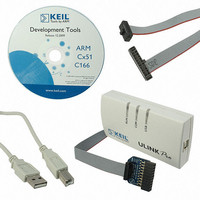ULINKPRO Keil, ULINKPRO Datasheet - Page 100

ULINKPRO
Manufacturer Part Number
ULINKPRO
Description
KIT DEBUG/TRACE UNIT HIGH SPEED
Manufacturer
Keil
Type
In-Circuit, Real-Time Debugger/Programmerr
Specifications of ULINKPRO
Contents
Module
For Use With/related Products
ARM7, ARM9, Cortex
Lead Free Status / RoHS Status
Lead free / RoHS Compliant
- Current page: 100 of 157
- Download datasheet (8Mb)
Getting Started: Creating Applications with µVision
Breakpoints Window
Invoke the Breakpoints
Window from the
Debug Menu.
You have to stop the
program running, to get
access to this dialog.
Modify existing
breakpoints and add new
breakpoints via this
dialog. Enable/disable
breakpoints using the
checkbox in the
Current Breakpoints list. Double-click on an existing breakpoint to modify its
definition.
Define a breakpoint by entering an Expression. Depending on the expression
entered, one of the following breakpoint types is defined:
An Execution Breakpoint (E) is defined when the expression specifies a
code address. This breakpoint is triggered when the specified code address is
reached. The code address must refer to the first byte of a microcontroller
instruction.
An Access Breakpoint (A) is defined when the expression specifies a
memory access (read, write, or both) instruction. This breakpoint is triggered
when the specified memory access occurs. You may specify the number of
bytes or objects (based on the expression) which trigger the breakpoint.
Expressions must reduce to a memory address and type. Operators (&, &&,
<. <=. >, >=, = =, !=) may be used to compare values before the Access
Breakpoint triggers and halts program execution or executes the Command.
A Conditional Breakpoint (C) is defined when the expression specifies a
true/false condition and cannot be reduced to an address. This breakpoint is
triggered when the specified conditional expression is true. The conditional
expression is recalculated after each instruction. Therefore, program
execution may slow down considerably.
99
Related parts for ULINKPRO
Image
Part Number
Description
Manufacturer
Datasheet
Request
R

Part Number:
Description:
MCU, MPU & DSP Development Tools USB-JTAG Adapter
Manufacturer:
Keil Tools
Part Number:
Description:
KEIL C-COMPILER INTERNATIONAL
Manufacturer:
Silicon Laboratories Inc
Part Number:
Description:
KEIL C-COMPILER US VERSION
Manufacturer:
Silicon Laboratories Inc

Part Number:
Description:
DEV KIT FOR STM32
Manufacturer:
STMicroelectronics
Datasheet:

Part Number:
Description:
KIT STARTER FOR STM32
Manufacturer:
STMicroelectronics
Datasheet:

Part Number:
Description:
KIT STARTER FOR STM32F10XE MCU
Manufacturer:
STMicroelectronics
Datasheet:

Part Number:
Description:
KIT STARTER KEIL FOR STR910
Manufacturer:
STMicroelectronics
Datasheet:

Part Number:
Description:
Microcontroller Modules & Accessories KEIL ULINK PRO 5V ADAPTOR KIT
Manufacturer:
Keil Software

Part Number:
Description:
Development Boards & Kits - ARM KEIL NUVOTON EVAL BD CORTEX-M0 + ULINK-ME
Manufacturer:
Keil Tools
Datasheet:

Part Number:
Description:
Development Boards & Kits - ARM KEIL NUVOTON EVAL BD CORTEX-M0
Manufacturer:
Keil Tools
Datasheet:

Part Number:
Description:
BOARD EVAL FOR LPC213X ARM MCU
Manufacturer:
NXP Semiconductors
Datasheet:
Part Number:
Description:
K60N512 Keil Tower Kit
Manufacturer:
Freescale Semiconductor
Datasheet:












